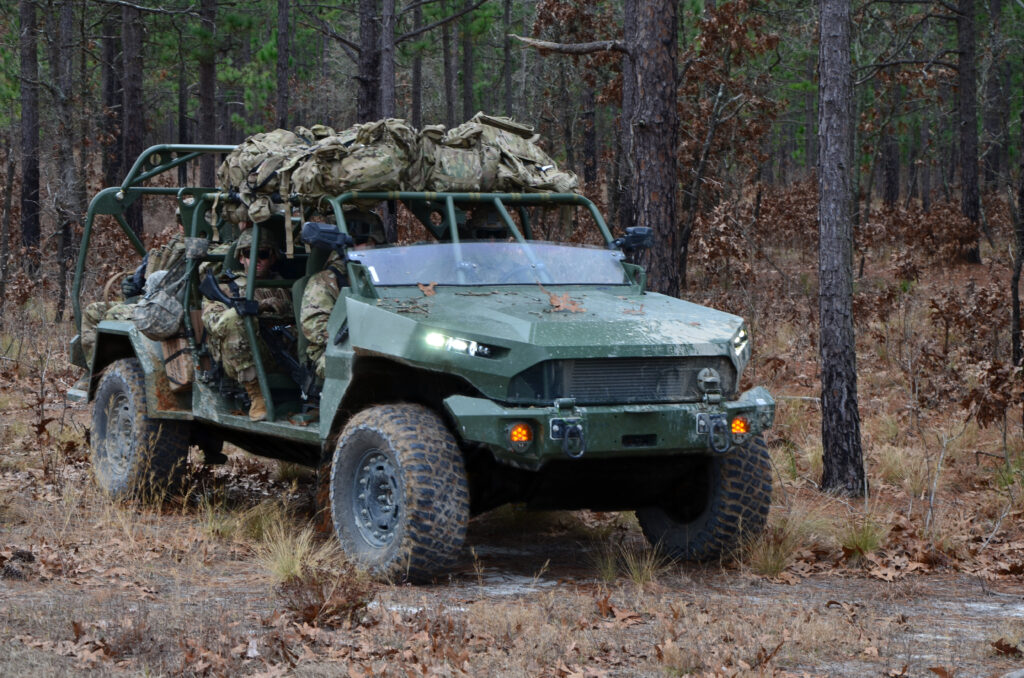
GM Defense Infantry Squad Vehicle (ISV)
WASHINGTON: Next year, two very different companies will face off for the right to build the Army’s mine-resistant 4×4, the Joint Light Tactical Vehicle. While other firms may yet decide to enter the race – most notably AM General, maker of the original Humvee – there are two entrants that have made their intentions very public.
The incumbent, Oshkosh, is deeply immersed in the unique requirements of the military world, even as it continues to build commercial vehicles. The challenger, General Motors, got out of the defense business 18 years ago and only reestablished its defense division in 2017. It does, of course, make millions of commercial vehicles every year.
[Click here for Part I of this story: JLTV: GM Defense’s Uphill Battle Vs. Oshkosh]
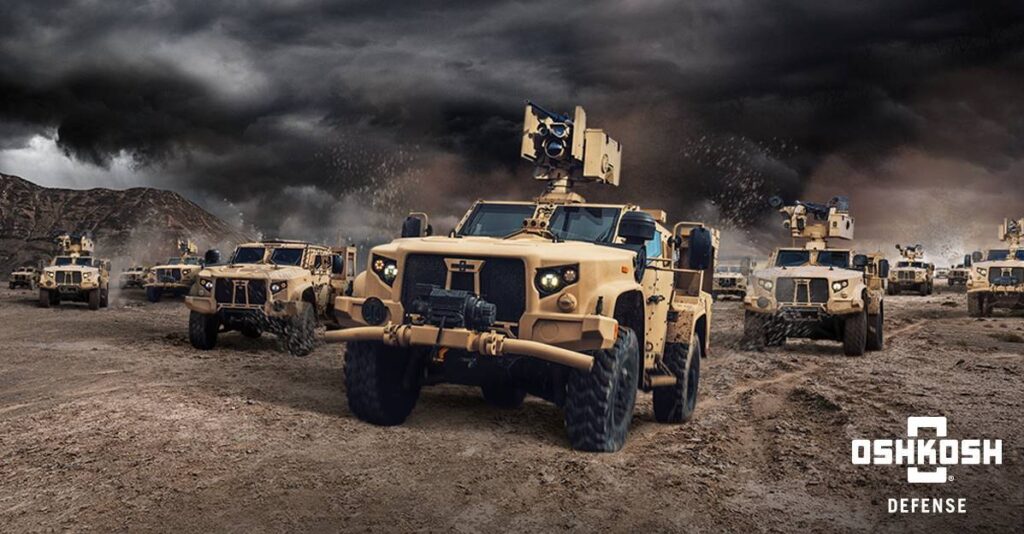
Joint Light Tactical Vehicle (JTV) variants in the field. (Oshkosh graphic)
Oshkosh: ‘They’re Not Commercial Trucks Painted Green’
Oshkosh has made military vehicles since World War II. Recently, it doubled down on the military market by partnering with Korean armored vehicle maker Hanwha to compete for the Army’s Optionally Manned Fighting Vehicle. But today, it’s famous for trucks. Tens of thousands of Oshkosh trucks dominate Army and Marine Corps motor pools, from ultra-heavy tank transporters to the 4×4 Joint Light Tactical Vehicle, the mine-resistant vehicle for frontline units.
“Oshkosh Defense is really unique,” said John Bryant, president of Oshkosh Defense, in an interview. “We’re really the only US tactical wheeled vehicle provider that has the entire portfolio of vehicles, from the heaviest, the Heavy Equipment Transporter, down to, of course, the Joint Light Tactical Vehicle.”
Despite their differences, these vehicles share many common components, design features, and engineering models, Bryant said, and they’re all custom-designed for the military.
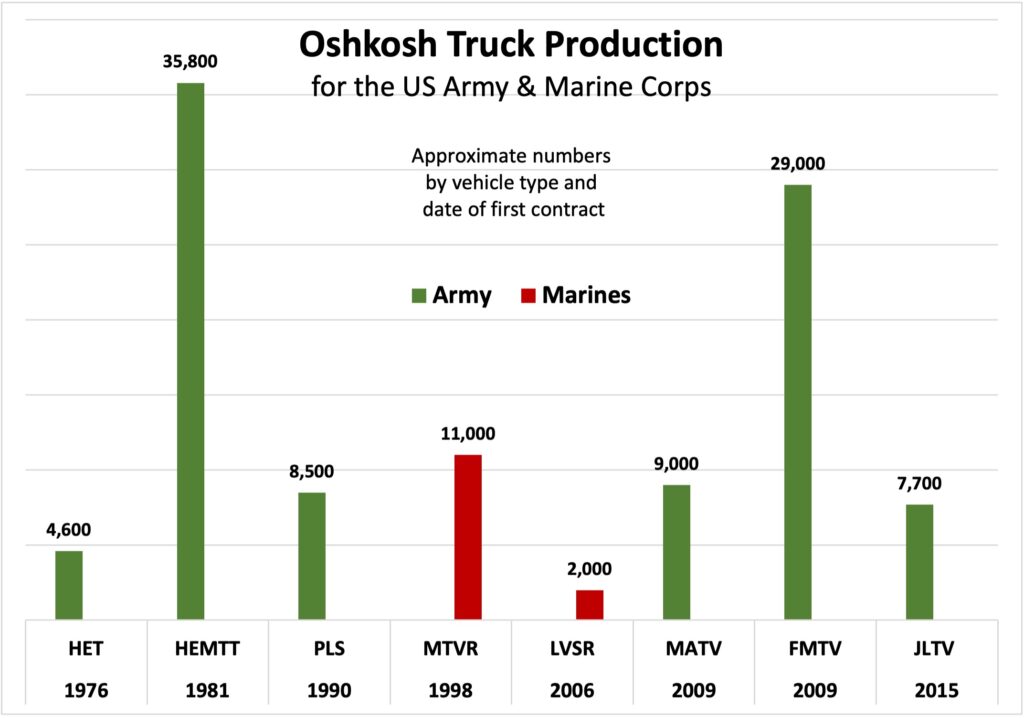
Breaking Defense graphic from Oshkosh data
“They’re not commercial trucks painted green.” he said. “An Oshkosh Defense vehicle is designed and built from the ground up to meet the particular needs of our military customer.”
That’s especially true for JLTV, which distilled a decade of experience with Mine-Resistant Ambush-Protected (MRAP) trucks in Afghanistan and Iraq – including Oshkosh’s own MRAP All-Terrain Vehicle, the M-ATV – into a much lighter and nimbler machine.
That presented a much greater technical challenge than traditional military trucks, Bryant said. So while Oshkosh could use many of its engineering models and simulations honed over the years – for things like cross-country mobility and suspensions – it had to develop extensive expertise in blast modeling and ballistic protection, first for the MRAP program and then, in greatly refined form, for JLTV.
As a result, Bryant boasted, “it really does have the protection of a light tank, the mine resistance of an MRAP, and the off-road mobility of a Baja racer. We actually did race it in the Baja.”
In 2015, Oshkosh beat aerospace titan Lockheed Martin and Humvee maker AM General – in large part on reliability grounds – for the right to build JLTV. It builds it on the same production line as its multi-axle military trucks and civilian vehicles.
“On our main line right now,” Bryant told me, “you might see a light tactical vehicle and behind it you might see it an FMTV; behind that you might see a front-end mixer that we’re producing for our commercial segment….We build all those vehicles on an integrated line.”
That makes life more complicated for the workforce, who get detailed digital instructions transmitted to their workstations on each specific vehicle that arrives. And it requires the just-in-time parts delivery system to deliver a wide range of different components on an intricate schedule. But by putting every vehicle on one integrated line, Oshkosh can reap assembly-line economies of scale even on lower-volume production runs.
Oshkosh actually got the cost per JLTV low enough that the military was able to buy them faster than expected and ran out of room on the existing contract, forcing the Army to issue another contract to keep production going through 2022.
That year is when the Army will reopen the JLTV competition to all comers. While Oshkosh doesn’t have to share its detailed assembly manuals or other how-to documentation, it was required to sell its Technical Data Package to the government, which will share it with potential competitors. Most prominent of those so far is GM Defense.
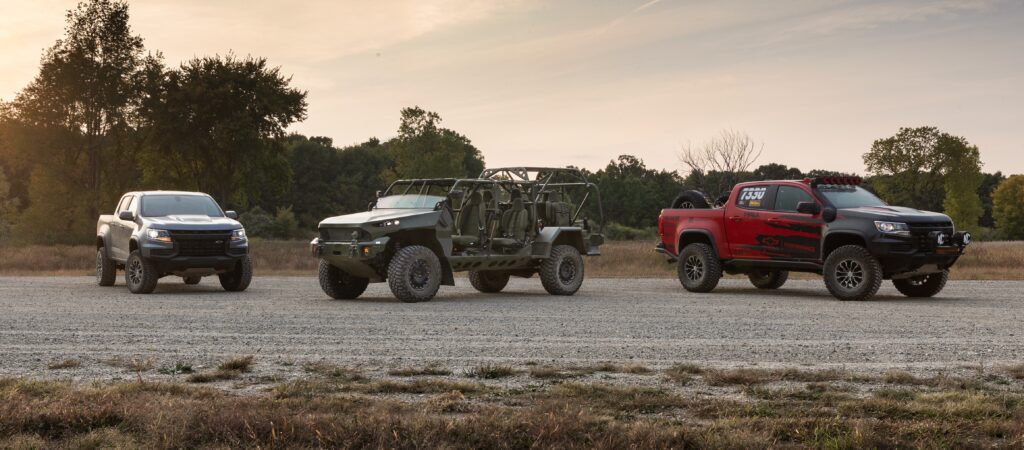
The GM Infantry Squad Vehicle (center) and its civilian ZR2 counterparts (flanking)
General Motors: ‘Orders of Magnitude Higher Volume’
General Motors was in the defense business for decades before it decided to sell its GM Defense unit to General Dynamics in 2003. 14 years later, in 2017, GM reestablished a defense subsidiary. The new GM Defense would leverage its parent company’s immense civilian engineering expertise and its vast network of suppliers.
The attraction for the military, said GM Defense senior engineer Rick Kewley, is that it gets to tap into the innovation and efficiency of commercial industry – which is, after all, a big part of how the US won World War II.
The difference in scale is striking. JLTV is a high-volume program by military standards, with the Army and Marines planning to build almost 60,000 vehicles – although that figure may come down. By contrast, General Motors builds nine million vehicles every year. That requires a supply base, an engineering team, and test facilities to match. “We have a safety lab where we crash a car a day,” Kewley said.
Compared to specialized defense firms, he said, “we’re talking orders of magnitude higher volume for every application.”
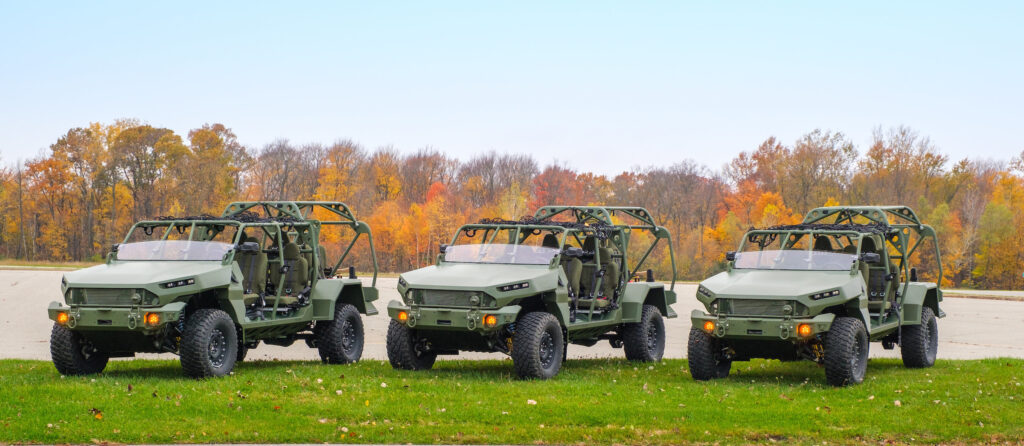
Three GM Defense Infantry Squad Vehicles (ISVs) ready for delivery to the Army.
So far, though, GM Defense itself is pretty small. Its biggest military program so far is a $214 million contract to build 651 Infantry Squad Vehicles, a militarized version of its ZR2 Chevy Colorado that’s tough enough to parachute from an airplane alongside airborne troops. The ZR2 made its name in off-road racing through Baja California, a grueling course that GM argues is a good model for military operation.
Now, the ISV is much lighter than the JLTV — 2.5 tons instead of seven (curb weight) — in large part because it’s much less heavily armored and reinforced against roadside bombs. JLTV also has more extensive military electronics.
“When you go to JLTV as opposed to [ISV], you’re now into additional technologies that aren’t immediately in the General Motors space,” Kewley acknowledged. GM can “understand, comprehend, and integrate” those technologies on its vehicles if partner companies provide them, he said, “but we don’t just have that actual capability in the company.”
In particular, “specialized work associated with blast attenuation is defense industry know-how,” he said. “The way GM gains that knowledge is by partnering with the defense industry.”
GM Defense has already bee in talks with potential teammates, he said, though it’s not ready to announce names just yet. Suffice it to say, Kewley told me, “there are some very welcoming companies out there that are interested in working and partnering with General Motors.”






















